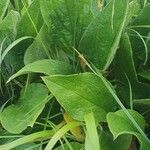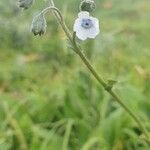Annual or biennial (rarely ? perennial) herb 0.2–1.2 m. tall, branched from the base or ± unbranched below but mostly with upper inflorescence-bearing part well-branched; taproot thick, up to 20 × 2 cm.; stems drying brownish, with sparse to dense white adpressed to spreading slightly tubercle-based hairs.. Leaves elliptic, lanceolate or elliptic-lanceolate, 2–13(–18) cm. long, 0.5–4(–5) cm. wide, acute at the apex, ± rounded at the base, scabrid with tubercle-based hairs from rings of cystoliths, breaking off to leave tubercles; venation ± impressed above, raised beneath; lower leaves with petioles developed, upper ± sessile.. Inflorescences terminal and axillary, usually characteristically divaricately bifid, rapidly elongating, 1–20 cm. long, the individual branches mostly (2.5–)4–1 3(–22) cm. long; flowers typically small; pedicels ± 1 mm. long up to 2.5 mm. and mostly recurved in fruit.. Sepals oblong, elliptic or ovate, 0.8–2 mm. long, 0.4–1.3 mm. wide, ± unequal and mostly 2 mm. long in fruit, with tubercle-based hairs outside.. Corolla usually white or sometimes pale blue or with a blue centre; tube 1 mm. long; lobes rounded-ovate to oblong, 0.5–2 mm. long, 0.5–1 mm. wide; anthers 0.5 mm. long; style 0.2–0.3 mm. long.. Fruits yellow-brown when ripe, 4–5 mm. wide, the nutlets subglobose-obovoid, 1.5–2 mm. in diameter, evenly covered all over with slender glochidia over 0.5 mm. long, separating easily at maturity; fruiting style ± 0.5(–1.3) mm. long, narrowly oblong and compressed, almost winged in dry state.. Fig. 29/2, p. 105.
Biennal (?) herb. Stem up to 100(-150) cm high, much branched, with longer, patent and shorter, atrorse hairs. Leaves lanceolate or oblong-lanceolate, petiole 1.5-3 cm long in lower, 0-1 cm in upper leaves, tapering towards base, acute, nerves very distinctly impressed on upper, prominent on lower side, upper side strigose with hairs arising from groups of mineralized cells, hairs on lower side subpaptent, a few longer, numerous shorter, denser along nerves. Inflorescences terminal on main stem and branches, furcate, cymes divaricate, scorpioid in flower, 3-10 cm long in fruit, abracteate; pedicels c. 1 mm long in fruit, curved downwards. Calyx 1-1.5 mm long in flower, 1.5 mm long in fruit, divided to base, lobes 0.5-0.8 mm wide, acute. Corolla white or dilute bluish, funnel-shaped, 2-3(-4) mm long, c. 3-4 mm in diam., glabrous, lobes ovate-suborbicular, 1(-1.5) mm long; fornices transverse linear, much wider than long. Stamens: filaments and anthers very short, anthers broadly ovate, much smaller than fornices, not reaching their base. Pistil: style very short, stigma indistinct. Nutlets ovate in outline, with nearly flat disc, 1.5-2.2 mm long, glochids equally distributed or less dense on disc, bases joined along margin.
Herbs perennial, 20-90 cm tall. Stems erect, branched from middle or below, densely hispid, hairs discoid at base; branches spreading. Basal and lower stem leaves petiolate, oblong-lanceolate, 8-14 × ca. 3 cm, abaxially densely pubescent, adaxially hispid and densely appressed pubescent, hairs discoid at base, base attenuate, apex acute; upper stem leaves sessile or short petiolate, lanceolate, smaller. Inflorescences terminal and axillary; branches spreading at an obtuse angle, ebracteate. Pedicel 1-1.5 mm, scarcely elongated in fruit. Calyx 1-1.5 mm; lobes ovate, densely short appressed pubescent outside, glabrous inside, slightly enlarged in fruit, apex obtuse. Corolla light blue, campanulate, 1.5-2.5 mm; throat appendages lunate; limb 2-2.5 mm wide. Anthers ovoid, ca. 0.5 mm. Style tetragonous, ca. 1 mm. Nutlets ovoid-globose, 2-2.5 mm, abaxially concave, with dense glochids, marginal glochids not confluent at base. Fl. and fr. Apr-Sep. 2n = 24.
Biennial, annual or sometimes perennial herb, 0.3-1.2(-1.8) m high. Stems divaricately branched. Leaves sessile; blade obovate, up to 120 x 15 mm, apex acute, venation of lower surface prominent with secondary nerves merged into 2 submarginal, well-marked nerves. Flowers: in helicoid inflorescences, divaricately branched, pedicels 1.0-2.5(-3.0) mm long in flowering, not elongated in fruit; corolla lobes 0.6-1.5 mm long, white or blue or with tube mauve and limb white or bluish and deep blue at throat; Nov.-Feb. Fruit of sessile or shortly stalked nutlets, stalks < 3 mm long, covered with glochidia.
Inferior leaves with petiole 2.5–8(13) cm. long, the superior ones almost sessile; lamina of the inferior leaves 8–15(20) x 2–4(6.5) cm., lanceolate to oblanceolate, that of the superior ones 2–6(8) x 0.4–1.8 cm., lanceolate to sublinear, roughish to shortly hispid above, roughish to pubescent below, acute at apex, attenuate at base and decurrent on the petiole; midrib and 2 lateral veins in all leaves usually prominent below.
Annual or biennial herb, 0.3-1.2 m high, divaricately branched. Leaves sessile; blade obovate, up to 120 x 15 mm, apex acute, venation of lower surface prominent. Flowers in helicoid inflorescences, divaricately branched. Corolla white or pale blue. Flowering time Nov.-Feb. Fruit of sessile or shortly stalked nutlets, stalks not more than 3 mm long, covered by glochidia.
Biennial or sometimes perennial herb, 0.3-1.2(-1.8) m high. Leaves with secondary nerves merged into 2 submarginal well-marked nerves. Pedicels 1.0-2.5(-3.0) mm long in flowering, not elongated in fruit. Corolla lobes 0.6-1.5 mm long. Flowers white or blue or with tube mauve and limb white or bluish but deep blue at throat.
A herb. It grows 1.8 m high. It has annual stems. These are bristly. The leaves are 8-15 cm long by 2-4 cm wide. The flowers occur all along the branches. They are 4 mm across. They are white or blue. The fruit is made up of 4 nutlets. These are covered with sticky hairs. There are 2 subspecies.
Corolla 1.5–2.6 mm. long, white or blue or with the tube mauve and the limb white or bluish but deep blue at throat, glabrous; tube 0.7–1.4 mm. long, campanulate; lobes 0.6–1.5 x 0.6–1.5 mm., oblong-ovate to subcircular, rounded at apex; fornices much broader than long, semilunar.
White-hairy annual or biennial to 1 m, mostly well-branched above. Leaves with midrib and 2 lateral veins usually prominent beneath. Flowers usually in divaricately bifid inflorescences, white or pale blue, pedicels to 3 mm long in fruit. Nutlets covered with slender glochidia.
Nutlets 1.5–2.5 x 1.2–1.8 mm. (without glochids), ovate, united to the style by a strap which detaches itself at complete maturity ± equally covered with 0.5–1.0 mm. long glochids; outer surface flat or convex, not marginate.
A biennial or sometimes perennial herb 0.3–1.2(1.8) m. high with erect annual stems, shortly hispid with antrorse hairs toward the apex, spreading below and sometimes retrorse near the base.
Calyx 1.0–1.5 mm. long, divided to near the base; lobes ovate to oblong-ovate, roughish to shortly hispid outside, ciliate, glabrous inside, rounded at apex.
Stamens inserted at 0.6–0.9 mm. from the base of the corolla tube; anthers 0.4–0.6 mm. long, oblong; Filaments 0.2–0.3 mm. long.
Flowers with pedicels 1.0–2.5(3) mm. long, a little accrescent and recurved in fruit.
Cymes ebracteate above the first flower, often divaricate.
Style thick, up to 1.5 mm. long in fruit.
A pilose herb 3-6 ft. high
White or bluish flowers.


